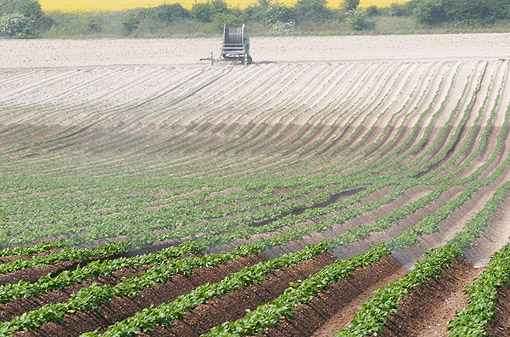Reducing the potato’s carbon footprint

The potato is strongly positioned as a sustainable crop in UK, but its continued success depends on the ability of the sector to adapt to changing circumstances, such as reducing the carbon footprint and water use.
Research has a key role in helping growers meet these challenges and this will be part of the discussion at a BP2011 seminar on the long-term implications of climate change later this month.
Supply chains are seeking to understand their own carbon footprint in order to improve energy efficiency and there will be pressure on growers to reduce their own carbon footprint.
Potato carbon and greenhouse gas emissions
Based on DEFRA data, the main components of the potato’s carbon footprint are fertilisers (30%), soil emissions (25%), field and store energy (29%) seed (9%) and transport (5%).
The roles played by fertilisers and pesticides are particularly important as carbon footprint is evaluated on a marketed yield basis.
Fertiliser production and use makes up 55% of the footprint when soil emissions, (including the important greenhouse gas nitrous oxide) are taken into account, so their efficient use is crucial to maximise yield and keep the footprint down.
Although pesticides compose only 2% of the total, their role in protecting tuber quality and marketable yield is particularly significant as any increase in waste will result in a raised footprint.
To address this, Potato Council projects at Cambridge University Farm are researching soil and cultivation management techniques and improving fertiliser use to help growers maximise marketable yield and minimise inputs where possible.
Water management
The work is also creating differences in bulk density, strength and rootability and, therefore, has implications for water management.
The second key area to the crop’s continued sustainability is growers’ capacity to adapt to changing water availability.
The most recent DEFRA survey reports that 49% of irrigated water in England and Wales is used for potatoes.
Unsurprisingly, the greatest demand for irrigation is in the eastern counties, but what will the future hold for irrigated and rain-fed production given changing weather patterns?
Potato Council-commissioned research by Cranfield University considered a number of different climate change scenario’s out to 2050 and concluded that with supplemental irrigation, the majority (around 85%) of the total arable land in central and eastern England would remain suitable for potato production.
This highlights the need for growers to adapt and protect their water resources for the future, investing in reservoirs and improving land management techniques.
Strategies could also include switching from rain-fed to irrigated cultivation in other areas, again requiring on-going investment in more efficient irrigation equipment and water management systems to cope with a drier summer climate.
In addition, growers may need to consider using different, drought tolerant cultivars and adapting their cultivation practices to cope with these new conditions.
Maintaining quality and yield by the use of irrigation impacts on production costs is, therefore, a priority research area.
Our R&D funds will be used to ensure effective use of soil and water resources and applied irrigation and to understand how crops can be managed to partition dry matter towards tuber production during periods of drought, rather than towards canopy production, thereby becoming more efficient at producing yields per unit of water use.
Key highlights
• Dr Storey will be holding a seminar on the results of reviews on crop sustainability and water use
• The results of the recent R&D survey will be announced, looking at growers’ R&D priorities
BP2011
Organised by the Potato Council, the biennial event takes place on 23 and 24 November at the Yorkshire Event Centre, Harrogate.
Growers can avoid the queues and walk straight in on the day by pre-registering and getting their free tickets in advance. Order now at www.potato.org.uk/events/bp2011
For more on farm energy, go to our dedicated Farm Energy area
Watch our video series on sustainable farming

